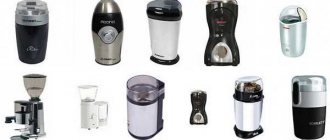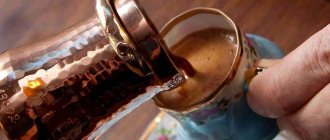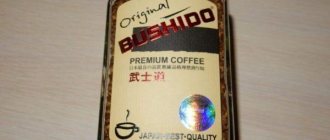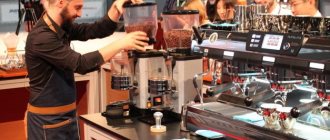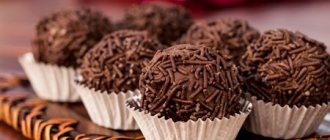Lani Kingston. “Perfect coffee. The Science and Art of Cooking"
Lani Kingston received her first education in the field of film and television, but for the past decade she has been professionally engaged in projects related to the food industry. She now runs the Four Seasons of Food agency, which specializes in consulting in the field of catering and food production. Lani has been writing articles about food and drink for various publications for quite some time, but “Perfect Coffee” is her first book.
How to Make Coffee: The Science Behind the Bean is the original title of this book. However, there is little written in it about how to prepare coffee: the section describing the step-by-step preparation of coffee in various devices takes up only a fifth of the book. Everything else is science: growing and producing coffee, the structure and chemical composition of coffee beans, processing and roasting processes, the subtleties of choosing water and frothing milk. Kingston's book can be read as a textbook that will help structure your knowledge about coffee and get an idea of how to prepare coffee correctly.
The book will appeal to those who want to dive into theory and look at coffee from a scientific point of view, as well as those for whom it is important to understand the basic principles of brewing any coffee.
“Perfect coffee. The Science and Art of Cooking" was published in 2015, translated into Russian and published by the KhlebSol publishing house in 2021. You can buy this book on the Torrefacto website.
Coffee capsules Lui
Lui coffee capsules are a real find for gourmets. Italians do not grow coffee, but they know all the intricacies of preparing an exquisite noble drink. And the coffee from the manufacturer fully meets the highest standards. In the product line you can find:
- classic Lui Espresso – real Italian espresso, giving a boost of energy for the whole day;
- with chocolate-cream aromas and tastes;
- with fruity and nutty flavors and aftertaste.
The secret to the popularity of the Louis brand is simple:
- use of elite coffee varieties;
- classic Italian roasting methods;
- continuity of traditions and innovative technologies.
Louis coffee machines and capsules are sold in the official store of the brand. Consultants will tell you in detail about the range of elegant tastes from Italy and help you place an order taking into account individual preferences.
James Hoffmann. "Coffee as a Profession: The Best of the Jimseven Blog"
The second book by the author of The World Atlas of Coffee, famous coffee expert and popularizer of specialty coffee, James Hoffmann, is a collection of selected articles from his blog. In the original it is called: The Best of Jimseven 2004-2015. The title “Coffee as a Profession” is here rather to make it immediately clear what this book is about and to whom it is addressed.
The book consists of four sections: “About espresso”, “About brewing coffee”, “Coffee business”, “About a career in coffee”. Each of them contains articles on a variety of topics, all of them are dated, but arranged not in chronological order, but in such a way as to create a certain logical sequence and structure. At the same time, the author himself says that “the book is designed in such a way that you can plunge into it from time to time, and not read from cover to cover.”
“Coffee as a Profession” is definitely not for beginners in the coffee world, but it will appeal to those who assume that they have already figured it all out and are ready to learn more. Hoffmann experiments, reflects, sometimes asks unexpected questions (my favorite is “What does an apple taste like?”), looks at familiar things from a different angle and makes us think: what do we really know about coffee?
The book was published in 2021, translated into Russian and published by Palmira publishing house in 2021.
Meet the most demanding espresso connoisseur. David Schomer's Precision Makes His Coffee Perfect
David Schomer will destroy your idea of morning coffee. His insistence on preparing espresso coffee to the strictest standards results in fine, gourmet coffee for customers who live in the city and know what real coffee is all about. One sip of Shomer's drink and you will never want anything else.
His methods and tastes are demanding, and his Espresso Vivace sets the gold standard for high-quality coffee. Coffee shops as far away as Georgia use its beans. He trains his 28 employees to adhere to strict standards. While Starbucks workers rush to learn the art of making coffee in about five days, new Vivace employees spend months just learning how to set up an espresso machine. They usually start out as coffee shop assistants, cleaning counters and tables and replenishing food supplies. They spend those first few months patiently observing the process while Shomer and his staff evaluate their talents before the newcomers are finally allowed to try their hand at making their own shot. In fact, the learning never ends—there is a mandate for the entire company to continue improving the espresso process. Schomer strives to create a staff of employees who are truly committed to their profession, and to teach them to view their work as creativity, and not just as a daily chore. “The best baristas are artists who want to make a living by constantly improving themselves,” says Schomer. “We try to teach them to see the beauty in coffee.”
Preparing the beans All beauty begins with the aroma of hay, this is exactly what green coffee beans smell like. Schomer and his staff buy samples from all continents (Brazil, Africa, East Asia), check the specimens for defects, and smell them to ensure there is no animal or fermentation odor. A small amount of the beans is then roasted to taste the true aroma of the beans and finally check for defects or absence. If the grains successfully pass inspection, a contract is signed with suppliers for a period of three months to a year. A new batch of goods remains on pallets until the unpleasant green taste of fresh beans is replaced by a wonderful citrus sourness, indicating normal acid content and readiness for roasting. The beans are roasted on site, blended to taste and packaged in plastic bags with a small hole to allow excess nitrogen to escape. The aroma reaches its highest point within a week after roasting, and then the beans can be ground and brewed. This is where the real precision begins. Schomer tested various grinding methods and settled on the traditional burr grinders used in Italy. Such a coffee grinder should produce up to 900 rpm. The coffee grinder knives must be very sharp so that they cut the grains and do not crush them like a pestle in a mortar. Shomer strives to obtain a homogeneous powder, the grind should be fine enough for the coffee to release all its rich aroma. If the grind is too coarse, the surface of contact between the coffee powder and water will be smaller, which means that the essential oils of the coffee will not be able to completely come out and will remain in the granules.
BrewingNext it's time to brew the coffee. The quality of finished espresso coffee depends as much on the brewing process as on the product from which it is prepared. Precision coffee brewing emerged in the early 20th century in Italy as a way to speed up the coffee preparation process. True espresso requires water under pressure to be forced evenly through the ground coffee, so the grind must be tightly and uniformly compressed. Schomer opts for traditional Italian heavy temperas with a flat base; he advises his baristas to apply 40 and 60 pounds of pressure to create a coffee tablet, then use a tamper to polish the surface. First, you need to heat the water properly, then run it through the coffee for 25 seconds. If you pour water too slowly, the coffee's aromatic oils will overheat and burn; If you run the water too quickly, the coffee will be weak, sour and astringent. This type of coffee is called ristretto (translated from Italian as “strong”), since the shot is quite short and the espresso contains a maximum of aromatic oils and extracts, while the bitter components remain in the coffee tablet. This creates a crema - a thick, dense layer of aromatic foam on top of the coffee. Schomer's success lies in combining a strong belief in science - (this is the man who characterizes the cream as a "multiphase colloidal foam") - with aesthetic demands. In his opinion, most coffee makers control either one (science) or the other (aesthetics), but not both. “If people who make espresso coffee were heart surgeons,” he says, “three-quarters of us would die on the operating table.”
Science and Art Schomer's introduction to coffee began in the 1970s at the Wet Whisker store on Pier 70 in Seattle, where he first learned the basics of coffee roasting as a customer. The store's owners later founded one of the most profitable companies, Seattle's Best Coffee, generating revenue of $130 million a year. In 1974, Schomer joined the Air Force and specialized in metrology, the precise science of measurement. His job brought him to the electronics laboratory at Boeing Seattle, which is the measurement standard around the world. Then in the mid-1980s he attended Cornwall College of Art, where he studied flute. He wanted to stay in Seattle, but knew local music acts wouldn't pay his bills. The city had been selling high-quality coffee for years, but its emergence as the capital of the coffee industry was just beginning, and it started with espresso carts springing up everywhere like mushrooms after rain. One day, on his way home from school, he glanced down Broadway—Seattle's main street adjacent to Capitol Hill—and saw an empty space near the local bank; he suddenly thought that this would be a great place for an espresso tray. So, in April 1988, Vivace appeared, and with it the wild popularity of coffee. At first, Schomer was very worried and irritated by the fact that he could not obtain consistently good quality coffee - his scientific mind was not satisfied with the unreliable results. He experimented with all the variables: grinding, coffee machine, bean quality. In 1994, he took on temperature, conducting a series of temperature measurements during extraction. He discovered a temperature range of up to eight degrees and began working to achieve a constant temperature. For Schomer and his associates, the pursuit of excellence is not only an opportunity to get great coffee, but also a symbolic kind of protest against corporate coffee at home (coffeedom). Just as the European Slow Food movement opposed McDonalds, Schomer's efforts can be seen as anti-Starbucks. “People like David really look at things differently. They say, “I don't want to offend the customer by serving him as quickly as possible. I ask permission to take a little more of his time to reward him with truly excellent coffee,” explains consultant Wilem Booth, who has opened coffee shops in the United States and Europe. “He has gained a lot of followers over the years.”
"Anything to Enhance the Flavor" While Schomer's main contribution is to the quality of his coffee, he is also known for introducing Americans to the art of "late art," the intricate and whimsical designs on the foam of cappuccinos, macchiatos and lattes, achieved by skillfully manipulating the cup and pitcher Traditional designs - rosette, or leaf - stripes of white foam and brown coffee define the shape of the design. Baristas also make hearts or thin concentric circles that radiate from the center of the cup like butterfly wings. The aesthetic value is undeniable, of course, but the whimsical approach is all science. “They naturally appear due to wave-like movements in a viscous fluid,” says Schomer. “The structure was needed to improve the aroma of the coffee - this remains unchanged.” In Italy, pictures on drinks have a half-century history, but this art has only occasionally penetrated overseas - partly because it requires a dense milk foam, which has nothing in common with the airy foam of local coffee shops. The folks at Vivace prepare a dense, rich mixture containing air but virtually no bubbles. If the mixture is properly prepared, the top is so smooth that it even shines. An added benefit of Schomer's determined commitment to quality is that it is very profitable from a financial point of view: Vivace has been profitable since 1992, even though its prices are slightly lower than in company stores. Perhaps then he saw the potential in an alternative form of coffee - and chose coffee quality as his main goal? Hardly. Schomer argues that his standards are nearly impossible to replicate in other cities; if they are repeated, it is only because for a modest fee he teaches those who want to, revealing his secrets to them. He does sell coffee online, but unlike others, he doesn't try to satisfy everyone's coffee cravings: “I want my establishments to remain local coffee shops.”
Perfect balance? After years of trial and error, Schomer finally solved the temperature dilemma - he found the ideal temperature for brewing coffee - 203.5 degrees Fahrenheit (95.3 degrees Celsius). If the temperature is even a little lower, the espresso will turn out sour and weak; if it is higher, bitterness and a burnt aftertaste will appear. It's this temperature that gives it the perfect combination: thick drink, smooth crema and natural acidity - a fluid work of art that needs to be drunk as quickly as possible. Solution: the use of PID control technologies in coffee machines, the most precise devices that ensure precise and constant temperature, which means consistent drink quality. These technologies were developed for robotics and high-tech manufacturing, not beverage production. However, he continues to study the process, again and again looking for flaws that he might have missed earlier. So one day he observed the process, and with frustration stated that in one of the machines there remained a slight deviation from the norm. Power surges in the network, perhaps? Humidity? Weather? The only way is to find out everything.
John Bonnet SEATTLE, May 9, 2003 msnbc.com
The article was translated by Jusmaster. Reproduction of materials without the written consent of Juicemaster is prohibited. The Law of the Russian Federation “On Copyright...” classifies translations as objects of copyright, preserving for them the same criteria for protection as for other works.
07 February 2009
Colin Harmon. “What do I know about the work of a coffee shop”
Four-time winner of the Irish Barista Championship and founder of 3fe (Third Floor Espresso), Colin Harmon shares his insights and insights into how to open and manage a coffee shop to achieve success.
This book can be read as a practical guide if you dream of owning your own coffee shop or have already opened one, but want to know what can be improved. It covers every aspect you need to pay attention to, from choosing a location, creating a business model and hiring staff, to communicating with guests, selling coffee packs and keeping toilets clean. I note that the first advice that Harmon gives to those who want to open their own establishment is to get a job in a cafe in order to understand how the hospitality industry works from the inside.
The book will be useful not only to coffee shop owners or those who are planning to open their own cafe, but also to baristas and establishment managers, as it contains many useful tips and tricks that will help improve service and was published in 2021, translated into Russian and published by the publishing house " ABC-Atticus" in 2021.
Louis line of coffee machines
The company produces capsule coffee machines of the following types:
- Lui Chic is a convenient and functional home coffee machine, characterized by stylish design and functionality.
- Lui Alex is one of the latest developments of the Lui brand, due to its laconic design and compact dimensions it is suitable for any interior.
- Lui Cup is a small compact coffee machine that can be used at home. Manufacturers equipped the unit with a capacity of one and a half liters, which was quickly appreciated by coffee lovers: many complain that models from other brands quickly run out of water.
- Lui Cube is additionally equipped with a cappuccino maker. With its help you can prepare a wide range of milk and coffee drinks.
- Lui Full Service – allows you to prepare a wide range of coffee and coffee-milk drinks. The unit is equipped with a capsule holder for 40 capsules, a capsule collector, and a tray for portioned sugar.
Using any model of coffee machine, you can prepare a high-quality rich drink. The units use pre-brewing technology, which allows you to fully preserve the beneficial properties of the beans and enhance the taste and aroma. It is worth noting the high quality of Italian capsule coffee. Manufacturers offer a wide range of rich and subtle flavors, both pure coffee and with various additives.
